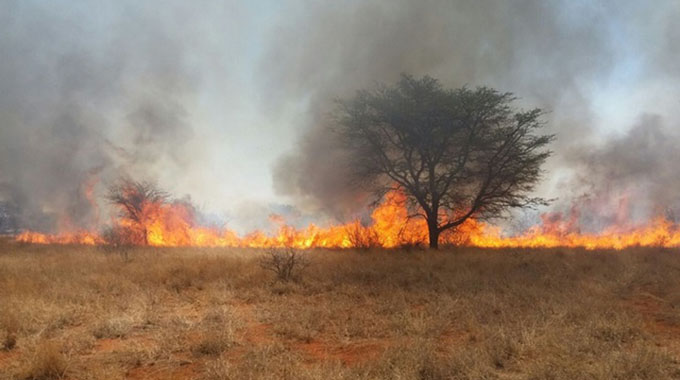Veld fire awareness for farmers

Veld fires have become one of the greatest environmental challenges of our time, causing intense damage to Zimbabwe’s natural flora and fauna, biodiversity, forests, animal habitats, crops and even leading to the loss of life and valuable property. Veld fires are defined as blazes that get out of control, become wild, and in the process destroy extensive tracts of forests, grasslands, animals, people and their properties. This burning has negative impacts which include; biodiversity loss, greenhouse gas emissions, loss of pastures, reduction in crop yields, soil fertility loss and the disruption of the hydrological cycle.
The 2018 fire season recorded a 16,7 percent reduction in fire incidences (1 595) compared with the previous year (2 705). A total of 1 190 174,89 hectares of land were burnt by veld fires in the current season while 1 268 534,31 hectares were burnt in the 2017 fire season, giving a difference of 78 359,42 hectares and a 6,2 percent reduction in area burnt as at October 31 2018. Sadly, 5 people died in inferno as compared to 6 in 2017.
How can Farmers Protect their Property from Veld Fires?
Every land owner has a responsibility to put in place the necessary fire suppression measures in and around their properties as stipulated in the Forest Act (Chapter 19:05) and Statutory Instrument 7 of 2007 (Environmental Impact Assessment and Ecosystems Protection) Regulations. According to these laws, it is an offence for land owners and occupiers not to take fire preventative measures such as the construction of standard fire guards which are at least 9 metres wide before the onset of the fire season. Fire protection on properties should be planned; it is much more effective if it is co-ordinated. Farm owners can unite to construct fire guards around their properties.
What Other Fire Protection Measures Should Farmers Take?
It is very important to plan the required fire protection measures in good time. A farmer needs to determine the precautionary measures that should be taken to limit the spread of a fire. The measures include the following;
The construction of fire guards that are at least 9metres wide along the farm boundary with the co-operation of your neighbour, by the months of May and June every year;
The construction of internal fire guards which are 4,5m wide around fields and plantations to protect crops;
Controlled burning of areas with thick vegetation to reduce biomass. This should however be done well before the fire season.
Ensure that fire fighting equipment is in place; bowsers or knapsack sprayers filled with water and fire beaters during the fire season.
Keep bowsers and knapsacks filled with water throughout the fire season.
Keep fire fighting equipment such as fire beaters at an accessible central point.
Use ox-drawn ploughs, tractors or hoes to construct fire-guards.
Inspect fire-guards regularly to make sure that they are free of any combustible material.
Organise and request Forestry Commission and EMA to train fire fighting teams for your farms or community.
Have fire alert systems such as drums, whistles and bells;
Listen to weather personnel on the fire danger index so as to improve their state of preparedness.
Bear in mind however, that no fire-guard will stop a fire in all conditions; fire-breaks enable farmers to fight or counter fires.
Veld Fires and the Collaborative Approach
A collaborative approach is needed when it comes to preventing veld fires. Farmers need to discuss with their neighbours on the fire protection measures and the steps they will take in the event of a fire. Neighbours formulate an action plan together so that each one knows what is expected of him/her in event of a fire. It is advisable that farmers enter into a written agreement with the owners of adjoining land with regards burning of fire-breaks, boundary agreed upon or on the common boundary. Fire-breaks needed on the boundary can be prepared together with adjoining owners. If an agreement cannot be reached on the construction of fire-guards, consult with local leadership. The agreement should state the date by which fire-guard construction should be completed, the width, length, location of the fire-guards and the sharing of costs.
Any person intending to undertake controlled burning should notify his neighbour at least 14 days in advance. It is advisable that the neighbour be present on the day of burning.
Some thoughts with regards to fire protection on the farm
Unintentional fires start countless times in ash pits; hot ash is thrown out and sets other flammable materials alight. Ensure that the area around the ash pit is clear of dry grass, crop residues and other materials that burn.
Send your feedback to; [email protected]. Follow us on Facebook; Environmental Management Agency and Twitter; @EMAeep or visit our website www.ema.co.zw . Alternatively, call us on: Tel 08677006244 and Toll-free 08080028; or use our WhatsApp platform 0779565707. We are ready to listen.











Comments